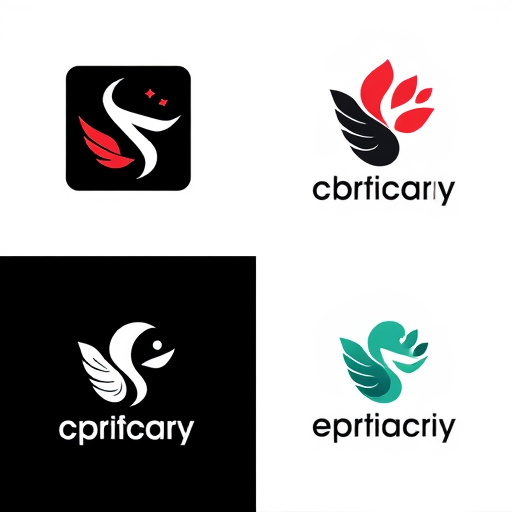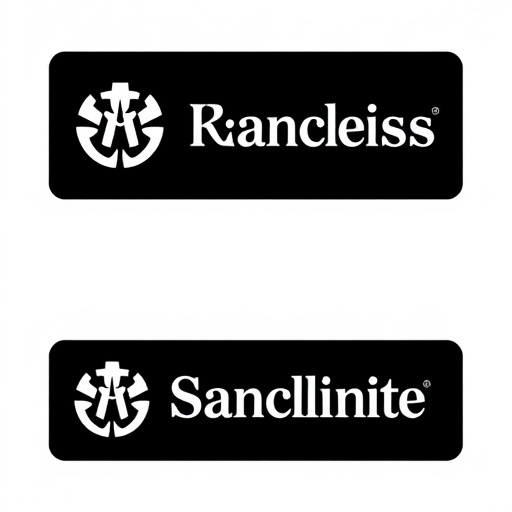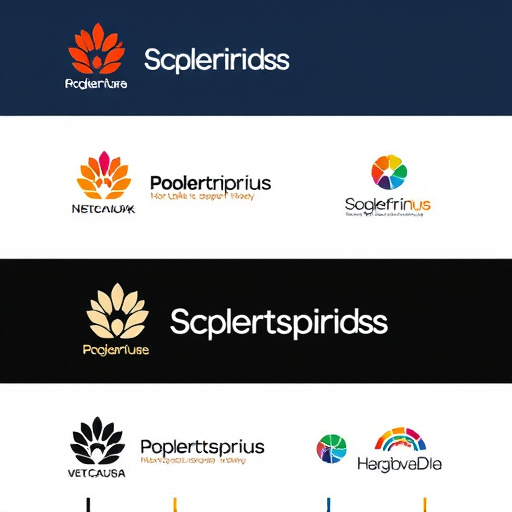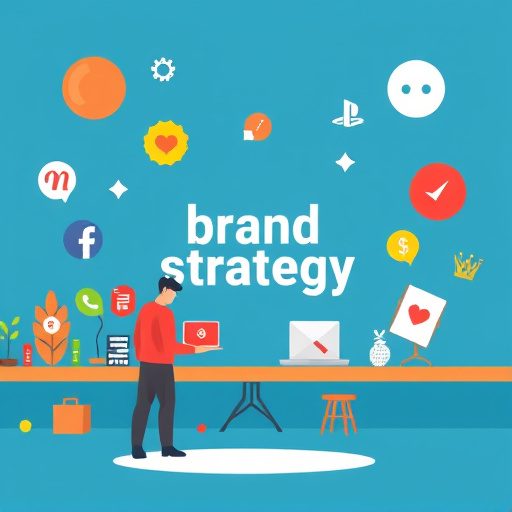Branding: Unlocking Business Success and Consumer Engagement
Introduction
In today’s competitive marketplace, branding has emerged as a powerful tool for businesses to differentiate themselves and captivate their target audiences. It is the art of crafting an identity—a unique promise and experience—that resonates with consumers, fostering loyalty and brand advocacy. This comprehensive article aims to delve into the intricate world of branding, exploring its historical roots, global impact, economic significance, technological adaptations, regulatory frameworks, and the challenges it faces. By the end, readers will grasp the multifaceted nature of branding and its role in shaping modern business landscapes.
Understanding Branding: The Essence and Components
Definition: Branding is the strategic process of creating and managing a brand—a name, term, symbol, design, or any other feature that identifies an organization’s products or services from those of competitors. It involves cultivating a unique brand identity, communicating it consistently across various touchpoints, and building relationships with customers.
Core Components:
-
Brand Identity: This includes the brand’s name, logo, visual style, and overall aesthetic. A strong brand identity is easily recognizable and differentiates the brand from competitors. For instance, the Nike “Swoosh” is instantly associated with sportswear globally.
-
Brand Values and Positioning: Defining the brand’s core values, mission, and positioning in the market is crucial. This involves understanding the target audience and communicating how the brand meets their needs better than alternatives. Apple’s focus on simplicity and user-friendliness is a prime example of powerful branding.
-
Brand Messaging and Communication: Effective branding requires consistent and compelling messaging across all communication channels, including advertising, marketing campaigns, website content, social media, and customer service interactions. Coca-Cola’s “Open Happiness” campaign has successfully engaged consumers worldwide.
-
Customer Experience: Branding extends to the overall experience customers have with a brand, from product quality and service to retail environment and post-purchase support. Starbucks’ cozy store ambiance and personalized coffee experiences are integral to their brand image.
Historical Context: Branding’s origins can be traced back to ancient times when artisans and merchants used symbols and signatures to distinguish their goods. Over centuries, branding evolved with the rise of mass production and marketing, leading to the sophisticated strategies we see today. The 20th century witnessed a surge in brand-building efforts, with iconic brands like Coca-Cola, McDonald’s, and Nike solidifying their positions globally.
Global Impact and Trends: A Unified or Diverse Branding Landscape?
Branding is a universal concept, yet its implementation varies across regions, reflecting cultural nuances and market dynamics. Here’s an overview:
| Region |
Key Trends/Influence |
Unique Branding Approaches |
| North America |
Focus on authenticity, transparency, and purpose-driven branding |
Storytelling and personal connections are popular, e.g., Patagonia’s environmental advocacy |
| Europe |
Emphasis on sustainability, diversity, and inclusive branding |
Many European brands prioritize eco-friendly practices, like IKEA’s commitment to sustainable materials |
| Asia Pacific |
Balance between traditional values and modern aesthetics, with a strong emphasis on community |
Japanese brands often blend minimalism with intricate craftsmanship, while Korean beauty brands focus on innovation |
| Middle East & Africa |
Rising influence of social media and celebrity endorsements; unique cultural branding |
Local brands in these regions are leveraging digital platforms for rapid growth, often blending traditional motifs with modern trends |
These regional variations showcase the diverse branding landscape, highlighting the need for adaptability and a deep understanding of local cultures.
Economic Considerations: Branding as a Market Driver
Market Dynamics
Branding plays a pivotal role in shaping market dynamics by influencing consumer choices and loyalty. A strong brand can command premium prices, attract investors, and foster a sense of community among customers. For instance, Apple’s powerful branding has allowed it to maintain high-price points for its products while enjoying immense customer loyalty.
Investment Patterns
Branding is a significant driver of investment decisions in the business world. Investors seek brands with solid reputations and growth potential. A well-branded company attracts investors, facilitates funding, and enhances its market valuation. Conversely, a weak brand may deter investments, impacting a company’s financial prospects.
Branding and Economic Systems
In advanced economies, branding is integral to the overall economic system, contributing to GDP and employment. It stimulates local and global trade, drives tourism, and influences consumer spending patterns. For instance, luxury brands like Louis Vuitton and Chanel contribute significantly to France’s economy through international sales and tourism.
Technological Advancements: Revolutionizing Branding Strategies
Technology has revolutionized branding, providing new avenues for engagement and customer interaction. Here are some key advancements:
-
Digital Marketing: The rise of digital platforms has transformed branding strategies. Social media, search engine optimization (SEO), influencer marketing, and content creation enable brands to reach global audiences instantly. For example, Instagram influencers have become powerful brand ambassadors, shaping consumer perceptions.
-
Data Analytics: Advanced analytics tools allow brands to gain profound insights into customer behavior and preferences. By analyzing vast data sets, companies can personalize their offerings, target specific demographics, and create tailored marketing campaigns, enhancing branding effectiveness.
-
Artificial Intelligence (AI): AI-powered chatbots and virtual assistants enhance customer service, providing instant brand interactions. Additionally, AI enables predictive analytics, helping brands anticipate trends and consumer needs, thus staying ahead in the market.
-
Augmented Reality (AR) and Virtual Reality (VR): These technologies offer immersive brand experiences, allowing customers to interact virtually with products before purchasing. IKEA’s AR app lets users place furniture in their homes digitally, revolutionizing the shopping experience.
Policy and Regulation: Navigating Legal Waters
The branding industry is subject to various policies and regulations designed to protect consumers, maintain fair competition, and safeguard intellectual property (IP). These include:
-
Trademark Laws: Protecting brand names, logos, and symbols from infringement is crucial. Trademark registration ensures legal protection and facilitates brand recognition.
-
Anti-Monopoly/Competition Acts: Preventing monopolies and promoting fair competition is essential for a healthy branding environment. These laws ensure that brands do not abuse their market power.
-
Consumer Protection Regulations: Ensuring transparency, accurate advertising, and fair business practices safeguards consumer rights. Brands must adhere to these regulations to maintain trust.
-
Data Privacy Laws (e.g., GDPR): With the rise of digital branding, data privacy has become a critical concern. Brands must handle customer data securely and transparently to comply with these regulations.
Challenges and Criticisms: Overcoming Obstacles
Branding faces several challenges in today’s dynamic business environment:
-
Saturation: In crowded markets, it becomes increasingly difficult for brands to stand out. This requires innovative strategies and a unique value proposition.
-
Changing Consumer Preferences: Rapidly evolving consumer tastes can make consistent branding challenging. Brands need to stay agile and responsive to trends while maintaining their core identity.
-
Ethical Concerns: With growing awareness, consumers are scrutinizing brands’ social and environmental responsibilities. Authentic and transparent branding addressing these concerns is essential for long-term success.
Solutions and Strategies:
-
Differentiation: Brands should focus on creating a unique value proposition that sets them apart from competitors. This involves careful market research and understanding of target audiences.
-
Adaptability: In a rapidly changing landscape, brands must be adaptable and quick to respond to trends. Agile branding strategies enable companies to stay relevant.
-
Transparency and Ethics: Building trust requires transparency in branding, especially regarding sustainability, social impact, and product quality. Ethical practices strengthen brand reputation.
Case Studies: Real-World Branding Success Stories
1. Apple Inc.: Innovation and Simplicity
Apple’s branding is a testament to the power of simplicity and innovation. Their iconic design language, led by Steve Jobs, has created a brand that evokes emotion and loyalty. Apple’s product launches are global events, generating immense hype and media coverage. The company’s focus on user experience and seamless integration across devices has fostered a sense of community among its users.
2. Nike: Just Do It—A Global Movement
Nike’s branding has successfully leveraged the “Just Do It” slogan to inspire athletes and fitness enthusiasts worldwide. Their marketing campaigns, featuring iconic sports figures and inspiring narratives, resonate with diverse audiences. Nike’s product quality, coupled with innovative designs, has solidified its position as a global sportswear leader. The brand’s ability to connect with people on an emotional level has led to strong brand loyalty.
3. Airbnb: Redefining Travel Experiences
Airbnb’s branding challenges the traditional hospitality industry by offering unique and authentic travel experiences. Their focus on community-driven content, where hosts share their local stories, has created a sense of trust among users. Airbnb’s marketing campaigns celebrate diversity and encourage people to embrace local cultures, fostering a global community around travel.
Future Prospects: Branding in the Digital Age
The branding landscape is poised for further transformation, driven by emerging trends:
-
Personalization: Advanced analytics and AI will enable hyper-personalized branding experiences, catering to individual consumer preferences.
-
Experiential Branding: Brands will prioritize immersive experiences, blending digital innovation with physical spaces to create memorable interactions.
-
Sustainability as a Brand Differentiator: With growing environmental consciousness, brands that embrace sustainability and ethical practices will gain a competitive edge.
-
Global Expansion through Digital Platforms: E-commerce and social media will continue to democratize branding, allowing smaller businesses to reach global audiences cost-effectively.
Conclusion: Branding—The Cornerstone of Business Success
Branding is not merely a marketing tool but a strategic asset that shapes business outcomes and consumer experiences. As the world becomes increasingly digital and connected, brands must evolve to meet evolving customer expectations. The successful integration of branding with technology, sustainability, and community engagement will be key to sustaining growth in the future. By understanding and leveraging the power of branding, businesses can forge lasting connections with their audiences, ensuring long-term success in a dynamic global market.
FAQ: Answering Common Branding Questions
Q: What is the difference between branding and marketing?
A: Branding is the overall strategy to create a unique identity for a product or service, while marketing involves the various tactics used to promote and sell those products or services to consumers. Marketing utilizes branding as a core element to communicate the brand’s value proposition effectively.
Q: Why is branding important for small businesses?
A: Branding helps small businesses differentiate themselves from larger competitors by creating a unique identity, fostering trust, and building loyalty among customers. Effective branding can attract a specific target audience, establish a competitive edge, and contribute to long-term business success.
Q: How does branding impact customer loyalty?
A: A strong brand builds trust, provides a sense of consistency, and evokes positive emotions in consumers. When customers perceive a brand as reliable, authentic, and aligned with their values, they are more likely to become loyal advocates, leading to repeat purchases and referrals.
Q: Can technology replace the need for branding?
A: Technology can enhance branding by providing new communication channels and opportunities for engagement. However, it cannot replace the core elements of branding, such as a unique identity, compelling messaging, and building relationships with customers. Instead, technology enables brands to connect more effectively and personally.
Reviewly Local Search is a dynamic tool that gives businesses real-time insights into brand mentions, reviews, and local trends, aiding data-driven marketing decisions. It enables swift identification of customer feedback, facilitating immediate…….
Continue Reading
Branding is a powerful tool for setting your business apart in a competitive market by creating a unique identity that connects with your audience, builds trust, and fosters loyalty. Reviewly Local Search specializes in branding through data-dri…….
Continue Reading
In the competitive digital era, Reviewly Local Search offers businesses a powerful tool to thrive by focusing on branded search within specific geographic areas. This platform enhances local visibility and manages online reputation through custo…….
Continue Reading
In today's digital era, local search is vital for business success as it connects companies with their target market, fostering trust and loyalty. Reviewly Local Search optimizes online presence through accurate listings, engaging content,…….
Continue Reading
Building a strong brand identity involves understanding your target audience's demographics, preferences, pain points, and aspirations. This knowledge drives tailored branding strategies that resonate deeply, from young millennials to tradi…….
Continue Reading
Reviewly Local Search is a powerful tool for businesses aiming to excel in their communities by analyzing authentic local customer reviews and ratings. It provides valuable insights into business performance, helping companies make data-driven d…….
Continue Reading
Local search is a powerful tool for businesses to connect with their community and build brand visibility in today's digital era. Reviewly Local Search, an online review platform, plays a crucial role in shaping brand perception. This artic…….
Continue Reading
Branding is a powerful tool in the digital age, where local search has become crucial for business visibility. Platforms like Reviewly Local Search enable businesses to optimize their online presence and strategies, leveraging positive customer…….
Continue Reading
Reviewly Local Search is a powerful tool for businesses aiming to refine their branding strategy, offering valuable customer insights through local search trend and review analysis. By leveraging this data, companies can make strategic decisions…….
Continue Reading
In today's digital era, online reviews are pivotal for local businesses aiming to thrive in a competitive market. Reviewly Local Search is a powerful platform that helps companies boost their local search rankings and visibility by encourag…….
Continue Reading
In today's digital era, consumers rely on online platforms to discover local businesses. Reviewly Local Search is a powerful tool that leverages customer feedback to boost visibility in local search results. By analyzing customer journeys a…….
Continue Reading
Reviewly Local Search is a powerful tool for local businesses aiming to increase online visibility, attract nearby customers, and build trust through authentic customer reviews. By optimizing for RLS, updating Google My Business profiles, incorp…….
Continue Reading
Brand recognition is vital for local businesses to stand out in competitive markets and attract customers through digital channels. Reviewly Local Search specializes in enhancing brand visibility via strategic digital marketing, optimizing onlin…….
Continue Reading
In today's digital age, Reviewly Local Search is a powerful tool for businesses aiming to enhance their online visibility and local search rankings. By integrating customer reviews, brands can build trust, attract new customers, and improve…….
Continue Reading
Reviewly Local Search is a powerful tool for businesses aiming to enhance their online visibility and local branding through customer feedback. By leveraging positive reviews, companies can attract more patrons and build trust, while effectively…….
Continue Reading
Reviewly Local Search is a leading platform optimizing local SEO for businesses, enhancing their online presence and branding. By focusing on customer reviews and advanced analytics, it helps brands increase footfall, engage customers, and build…….
Continue Reading
In today's competitive marketplace, local branding is vital for small businesses aiming to differentiate themselves and connect with their communities. Reviewly Local Search offers a comprehensive platform that enables business owners to un…….
Continue Reading
Reviewly Local Search is a powerful tool for businesses aiming to excel in their local markets by providing a centralized hub for customers to discover, engage, and review nearby brands. Integrating this platform enhances customer engagement, dr…….
Continue Reading
In a competitive business landscape, Reviewly Local Search is a game-changer for small businesses aiming to boost online presence. This platform, leveraging user-generated reviews and strategic marketing, helps firms gain visibility, attract cus…….
Continue Reading


















